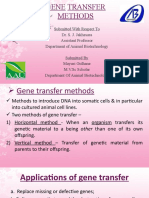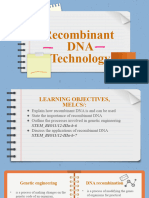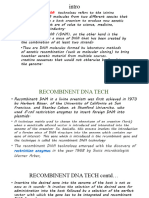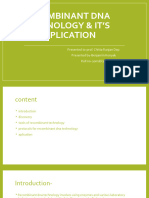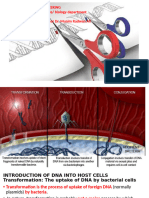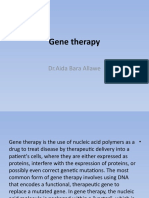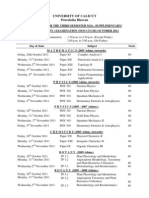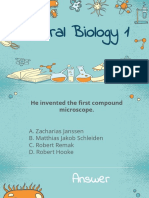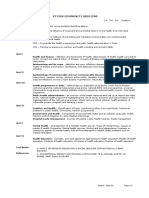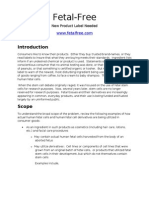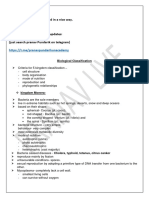0 ratings0% found this document useful (0 votes)
Animal Transformation
Animal Transformation
Uploaded by
Rejayne JuyadAnimal transformation notes
Copyright:
© All Rights Reserved
Available Formats
Download as PDF, TXT or read online from Scribd
Download as pdf or txt
Animal Transformation
Animal Transformation
Uploaded by
Rejayne Juyad0 ratings0% found this document useful (0 votes)
Animal transformation notes
Original Title
ANIMAL-TRANSFORMATION
Copyright
© © All Rights Reserved
Available Formats
PDF, TXT or read online from Scribd
Share this document
Did you find this document useful?
Is this content inappropriate?
Animal transformation notes
Copyright:
© All Rights Reserved
Available Formats
Download as PDF, TXT or read online from Scribd
Download as pdf or txt
0 ratings0% found this document useful (0 votes)
Animal Transformation
Animal Transformation
Uploaded by
Rejayne JuyadAnimal transformation notes
Copyright:
© All Rights Reserved
Available Formats
Download as PDF, TXT or read online from Scribd
Download as pdf or txt
You are on page 1/ 29
ANIMAL
TRANSFORMATION
Prepared by: Angelica P. Maderse, MSc
HISTORY
• 1928: Frederick Griffith demonstrated the first transformation.
– Found that a strain of Streptococcus pneumoniae could
be virulent when exposed to heat-killed virulent strains
– Hypothesized “transforming principle”
• 1944: Avery Oswald and colleagues discovered that this
process is genetic
– Isolation and insertion of DNA from virulent strain of
Streptococcus pneumoniae into harmless strain called
the process transformation
• 1947 & 1953: The results of Avery et al. were accepted
– Development of genetic markers and discovery of other
methods of transformation greatly helped to clear doubts
HISTORY
• 1970: Morton Mandel and Akiko Higa
acknowledge the use of E. coli to be used to
take up DNA
• 1972: Stanley Cohen et al., showed that CaCl2
may used to transform plasmid DNA
• 1980’s: Electroporation was developed as a
method of transformation and invention of
Biolistic Particle Delivery System (gene gun) by
John Sanford
• 1982: First transgenic mouse created
What is Animal Transformation?
• Process where a foreign DNA is introduced and
incorporated/inserted into the cell of living organisms
(animal cell) causing genetic alteration of that cell
– A natural form of genetic exchange/ gene transfer
– In bacterial genetics, this process was described the
uptake of naked plasmid or genomic DNA (essentially
any DNA which had the potential to transform the
phenotype of the recipient cell)
– Concerning animal transformation, the term most often
used is “transfection”
• As “transformation” refers to the progression of
animal cells into cancerous state
Process of Transfection
• was used specifically to describe the uptake of naked
phage DNA (or RNA), i.e. nucleic acid which had the
potential to initiate a phage replication cycle.
• Two types of Transfection:
a. Transient- transfected DNA not integrated to host
chromosome (create temporary expression)
b. Stable- transferred DNA is integrated (inserted) into
host chromosomal DNA and genetics of recipient
cells is permanent changed/ expression
• Different methods of transfection have different approach
in delivering/inserting foreign DNA
– Ideal method must be high transfection efficiency, low
cell toxicity, minimal effects on normal physiology, be
easy to use and reproducible.
Methods of Transfection
• Divided into 3 categories:
1. Physical methods
– Electroporation 3. Virus-based method
– Micro injection
– Laser injection
– Biolistic particle delivery
2. Chemical methods
– Calcium phosphate
– Cationic lipids
– DEAE-Dextran
– Cationic polymer
Methods of Transfection
• Chemical Method
– used naked DNA which was mixed with particular
chemicals to form synthetic complexes which either
interact with the cell membrane and promote uptake by
endocytosis, or fuse with the membrane and deliver the
DNA directly into the cytoplasm.
• Physical method
– involve breaching the cell membrane and introducing
the nucleic acid directly into the cell or nucleus.
• Virus-based method
– deliver their nucleic acid cargo to the nucleus as part of
the infection cycle, often after interaction with cell
surface receptors and either internalization within
endosomes or direct fusion with the plasma
membrane.
Physical Method: Electroporation
• Was first used to transfect mouse lyoma
cells by Neumann and colleagues in 1982
• Allows transfection of cells following their
exposure to a pulse electric field
– Cause a number of nanometer-sized
pores to open in the plasma membrane
for up to 30 minutes allowing uptake of
free DNA from surrounding medium
– When field is turned off, pores close
spontaneously, enclosing the DNA
inside
Electroporation
Advantages Disadvantages
– High efficiency – Requires specialized
– Highly reproducible capacitor discharge
– Don’t alter the biological equipment (controlling
structure of cells pulse length and
voltage)
– Can be used in different
cell lines – High level of cell death
– Copy number of
transgene can be at
least partially controlled
Microinjection
• provides direct nuclear delivery of DNA avoiding the
endogenous pathway and also ensures that the DNA is
delivered intact.
• Uses: in introduction of DNA into oocytes, eggs,
embryos of animals either for transient expression
analysis or to generate transgenic animals
• This method was used for transforming cells that were
resistant to any other method of transfection
• Stable transfection efficiencies are extremely high, in the
order of 20%, and very small quantities of DNA are
sufficient.
Biolistic particle delivery
• Known as or micro-projectile transfection
• delivery of nucleic acids into host cells via high-velocity
nucleic acids coated micro particles
• Involves projecting microscopic heavy metal particles
(gold/tungsten) coated with nucleic acids into host
recipient cells at high velocity using a biolistic device (i.e.
“gene gun”)
• Used to transiently transfect dividing/non dividing cells in
culture and in vivo
• Use in transforming of maize and generating transgenic
cereal plants
• Use in vaccination
Biolistic Particle delivery
Advantages Disadvantages
• Simple and rapid • Generally have lower
technique efficiency
• Use small amount of DNA • Requires preparation of
• Can delivery large micro-particles
amounts of DNA • Instrument cost
fragments
• Requires little
manipulations of cells
• High reproducibility
Laser injection
• Use laser light to transiently permeabilize a large number
of cells in very short time
• Various substances (ions, small molecules (siRNAs,
plasmid, protein) can be efficiently laser injected into
numerous cell types
• When the laser induces a pore in the membrane, the
osmotic difference between the medium and cytosol
facilitates the uptake of nucleic acid into the cell
Calcium Phosphate
• Was first chemical transfection method used in animal cells.
• Used in transient and stable transformation
• Technique where DNA in buffered phosphate solution is mixed
gently with calcium chloride that causes the formation of a fine
DNA-calcium phosphate co-precipitate which settles onto
the cells and some are taken up by endocytosis
• The DNA escapes and reaches the nucleus and can be
expressed
• Procedure was developed in 1973 by Graham and van der
Erb for introduction of adenovirus DNA in rat cells
Calcium Phosphate
Advantages Disadvantages
• Easily available • Low efficiency
• Inexpensive • Not suited for in vivo
• Can be applied to wide gene transfer to whole
range of cell types animals
• Can be used for transient • Size and quality of
and stable transfection precipitate are crucial to
• CP appears to provide success of transfection
protection against
intracellular and serum • Toxicity especially to
nucleases primary cells
DEAE- DEXTRAN
• Was first non-viral transfection method verified by
Vaheri and Pagano in 1965
• A soluble polycationic carbohydrate that tightly
associates with negatively charges of nucleic acids
(electrostatic interactions) and promote uptake by
endocytosis
• Aggregates formed are small compared to particles
formed during calcium phosphate transfection
DEAE-DEXTRAN
Advantages Disadvantages
• Inexpensive • High concentration of
• Easy to perform and DEAE-Dextran can be
quick toxic to the cell
• Can be applied to wide • Transfection efficiency
range of cell types varies with cell types
• Can be used only for
transient transfection
• Produced less than 10%
delivery in primary cells
Cationic Lipid
• Electrostatic interactions between positive charge of
cationic lipid head groups and negatively charged
phosphates of DNA backbone are main forces that allow
DNA to spontaneously associate with cationic lipids
• It is mixed with neutral lipid (L-
dioleoylphosphatidylethanolamine (DOPE) which can
enhance the gene transfer ability of certain synthretic
lipids
• When liposome encounter nucleic acids, they form
complexes called “lipoplexes” that can be actively
taken up by host cell through endocytosis
• Its successful depend on the factors (lipid
formulation, particle size and method of
preparation)
• An overall net positive charge of complex allow
association of complex with negatively charge of
cell membrane
Cationic Polymer
• Differ from cationic lipid in that they don’t contain a
hydrophobic moeity and are completely soluble in water
• Includes polybrene, polyethyleneimine (PEI) and
dendrimers
• Ability of cationic polymer more efficiently condense with
DNA
• Cationic polymer cant release their DNA load into
cytoplasm
Virus-mediated Transfection
• Most commonly used method in clinical research
• Known as transduction - transfer of exogenous nucleic acid into
animal cells as part of a recombinant viral particle
– Transgenes may incorporated into viral vectors by addition to
whole genome or by replacing one or more viral genes (done by
ligation or homologous recombination)
• Enveloped virus- deliver nucleic acid by binding to specific
receptors on the cell surface and then by either fusing directly with
the plasma membrane or, following uptake by endocytosis, by fusing
to the endosomal membrane
– Ex. Herpes virus, Retro virus (murine leukemia virus (MLV)
• Non-enveloped viruses- penetrate or disrupt the plasma or
endosomal membranes with specific virion proteins.
– Ex. adenovirus
Retrovirus-Mediated Gene Transfer
• Earliest method for
successful gene transfer in
mammals
• Virus gene is replicated with
transgene gene
• Method was successfully
used in 1974 when a simian
virus was inserted into mice
embryos resulting in mice
carrying this DNA
Virus-Mediated Transfection
Advantages Disadvantages
• Strong immune reactions
• Very high gene delivery against viral proteins
efficiency (95-200%) prohibit multiple
administrations
• Simplicity of infection
• Possibility of chromosomal
insertion and proto-
oncogene activation
• Complicated synthesis
process
• Toxicity, contamination of
live virus
Application of Animal
Transformation
• Gene therapy
• Production of transgenic animals
You might also like
- Indirect and Direct Methods of Gene Transfer100% (3)Indirect and Direct Methods of Gene Transfer4 pages
- Direct Methods of Gene Transfer in PlantsNo ratings yetDirect Methods of Gene Transfer in Plants17 pages
- Gene Cloning: Zoology Sem 2 Apurva PatelNo ratings yetGene Cloning: Zoology Sem 2 Apurva Patel42 pages
- Dna Recombinant Technology: Topic: Various Techniques of DNA Introduction in Target OrgansNo ratings yetDna Recombinant Technology: Topic: Various Techniques of DNA Introduction in Target Organs26 pages
- Recombinant Dna Technology & It's ApplicationNo ratings yetRecombinant Dna Technology & It's Application20 pages
- 2.1 Basic Principles of Genetic EngineeringNo ratings yet2.1 Basic Principles of Genetic Engineering56 pages
- Lecture 4 - Transferring Gene Into Mammanlian CellsNo ratings yetLecture 4 - Transferring Gene Into Mammanlian Cells47 pages
- Biotechnology Principles and Processes 35063599 2024 06-11-23 11No ratings yetBiotechnology Principles and Processes 35063599 2024 06-11-23 1123 pages
- Notes CH-11 Biotechnology and Its PrinciplesNo ratings yetNotes CH-11 Biotechnology and Its Principles6 pages
- Module 5-Lecture 3 Gene Transfer Techniques: Physical or Mechanical MethodsNo ratings yetModule 5-Lecture 3 Gene Transfer Techniques: Physical or Mechanical Methods10 pages
- Transformationandtransfectionfinal 180609201420 PDFNo ratings yetTransformationandtransfectionfinal 180609201420 PDF35 pages
- Introduction To Prokaryotic Genetics - TransformationNo ratings yetIntroduction To Prokaryotic Genetics - Transformation24 pages
- Alhmedllah Final DNA Recombination_241002_103549No ratings yetAlhmedllah Final DNA Recombination_241002_10354979 pages
- Lecture 24: Biotechnology: Dr. Kim GreenNo ratings yetLecture 24: Biotechnology: Dr. Kim Green23 pages
- Biology Unit 4 - The Natural Environment and Species SurvivalNo ratings yetBiology Unit 4 - The Natural Environment and Species Survival31 pages
- C51-Molecular techniques(Dr amitosh K saxena)No ratings yetC51-Molecular techniques(Dr amitosh K saxena)30 pages
- Microbiology: a QuickStudy Laminated 6-Page Reference GuideFrom EverandMicrobiology: a QuickStudy Laminated 6-Page Reference Guide5/5 (1)
- Synergistic Activation of Doxorubicin Against Cancer: A ReviewNo ratings yetSynergistic Activation of Doxorubicin Against Cancer: A Review6 pages
- University of Calicut Pareeksha Bhavan: ST ND TH THNo ratings yetUniversity of Calicut Pareeksha Bhavan: ST ND TH TH3 pages
- Genetic Engineering: Genetic Engineering Is Defined As The Deliberate Modification of Genes in Order To AlterNo ratings yetGenetic Engineering: Genetic Engineering Is Defined As The Deliberate Modification of Genes in Order To Alter4 pages
- NonClinical Labs Inspections List (10-1-2000 Through 9-27-2020)No ratings yetNonClinical Labs Inspections List (10-1-2000 Through 9-27-2020)78 pages
- Fetal-Free: New Product Warning Label Needed100% (1)Fetal-Free: New Product Warning Label Needed11 pages
- Summary Notes - Topic 1 Characteristics and Classification of Living Organisms - CIE Biology IGCSENo ratings yetSummary Notes - Topic 1 Characteristics and Classification of Living Organisms - CIE Biology IGCSE3 pages
- Phil-Iri Questions Grade 10 Phil-Iri Questions Grade 10100% (1)Phil-Iri Questions Grade 10 Phil-Iri Questions Grade 102 pages
- Microbial Identification in The Pharmaceutica IndustryNo ratings yetMicrobial Identification in The Pharmaceutica Industry11 pages
- Dr. Sumait Hospital: Final Investigation ReportNo ratings yetDr. Sumait Hospital: Final Investigation Report10 pages
- TRS 910 Annex2-WHO Revision of The WHO Recommendations For The Production and Control of IPVNo ratings yetTRS 910 Annex2-WHO Revision of The WHO Recommendations For The Production and Control of IPV28 pages
- Genome Database & Information System For Daphnia: @bio - Indiana.eduNo ratings yetGenome Database & Information System For Daphnia: @bio - Indiana.edu14 pages
- Student Exploration: Evolution: Mutation and SelectionNo ratings yetStudent Exploration: Evolution: Mutation and Selection7 pages
- Hole's Essentials of Human Anatomy & Physiology Twelfth Edition - Chapter 4 Lecture OutlineNo ratings yetHole's Essentials of Human Anatomy & Physiology Twelfth Edition - Chapter 4 Lecture Outline47 pages
- Dna Recombinant Technology: Topic: Various Techniques of DNA Introduction in Target OrgansDna Recombinant Technology: Topic: Various Techniques of DNA Introduction in Target Organs
- Lecture 4 - Transferring Gene Into Mammanlian CellsLecture 4 - Transferring Gene Into Mammanlian Cells
- Biotechnology Principles and Processes 35063599 2024 06-11-23 11Biotechnology Principles and Processes 35063599 2024 06-11-23 11
- Module 5-Lecture 3 Gene Transfer Techniques: Physical or Mechanical MethodsModule 5-Lecture 3 Gene Transfer Techniques: Physical or Mechanical Methods
- Transformationandtransfectionfinal 180609201420 PDFTransformationandtransfectionfinal 180609201420 PDF
- Introduction To Prokaryotic Genetics - TransformationIntroduction To Prokaryotic Genetics - Transformation
- Biology Unit 4 - The Natural Environment and Species SurvivalBiology Unit 4 - The Natural Environment and Species Survival
- Microbiology: a QuickStudy Laminated 6-Page Reference GuideFrom EverandMicrobiology: a QuickStudy Laminated 6-Page Reference Guide
- Synergistic Activation of Doxorubicin Against Cancer: A ReviewSynergistic Activation of Doxorubicin Against Cancer: A Review
- University of Calicut Pareeksha Bhavan: ST ND TH THUniversity of Calicut Pareeksha Bhavan: ST ND TH TH
- Genetic Engineering: Genetic Engineering Is Defined As The Deliberate Modification of Genes in Order To AlterGenetic Engineering: Genetic Engineering Is Defined As The Deliberate Modification of Genes in Order To Alter
- NonClinical Labs Inspections List (10-1-2000 Through 9-27-2020)NonClinical Labs Inspections List (10-1-2000 Through 9-27-2020)
- Summary Notes - Topic 1 Characteristics and Classification of Living Organisms - CIE Biology IGCSESummary Notes - Topic 1 Characteristics and Classification of Living Organisms - CIE Biology IGCSE
- Phil-Iri Questions Grade 10 Phil-Iri Questions Grade 10Phil-Iri Questions Grade 10 Phil-Iri Questions Grade 10
- Microbial Identification in The Pharmaceutica IndustryMicrobial Identification in The Pharmaceutica Industry
- TRS 910 Annex2-WHO Revision of The WHO Recommendations For The Production and Control of IPVTRS 910 Annex2-WHO Revision of The WHO Recommendations For The Production and Control of IPV
- Genome Database & Information System For Daphnia: @bio - Indiana.eduGenome Database & Information System For Daphnia: @bio - Indiana.edu
- Student Exploration: Evolution: Mutation and SelectionStudent Exploration: Evolution: Mutation and Selection
- Hole's Essentials of Human Anatomy & Physiology Twelfth Edition - Chapter 4 Lecture OutlineHole's Essentials of Human Anatomy & Physiology Twelfth Edition - Chapter 4 Lecture Outline














